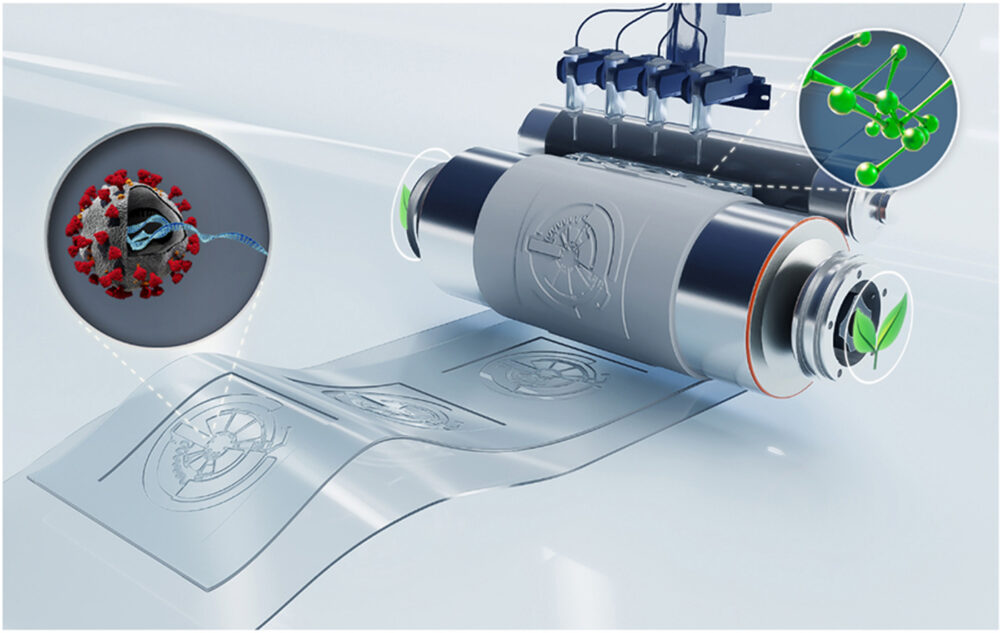Leveraging the CADworks3D PR110 printer and the Master Mold for PDMS Resin, a team of researchers at Sungkyunkwan University in South Korea paved the way for a scalable and green manufacturing process for polydimethylsiloxane (PDMS)-based microfluidic devices.
CADworks3D's Master Mold for PDMS Device Resin empowers a sustainable and low-cost method of mass producing Lab-on-a-Disc Devices
Hoang et al. (2023) have reimagined classic roll-to-roll (R2R) manufacturing technology and transformed it to develop a sustainable R2R additive manufacturing platform for fabricating PDMS-based Lab-on-a-Disc (LoaD) microfluidic devices.
Their innovative approach seamlessly integrates 3D printing and imprinting technology to address traditional molding challenges of LoaD devices. They also introduce a novel PDMS formulation with Ashby-Karstedt catalyst that effectively accelerates the curing time of PDMS at room temperature. In combination, the resulting R2R platform eliminates the need for light and heat sources, significantly reducing energy consumption, the emission of greenhouse gases, and hazardous by-products. As such, this technology demonstrates an efficient and environmentally conscious solution for high throughput PDMS device fabrication.
HOW WAS THE CADWORKS3D SYSTEM USED?
The CADworks3D Pr110-385 3D printer and Master Mold for PDMS Resin were pivotal in creating a multi-depth negative stamp master that incorporated both macro- and micro-sized structures. The team used the 3D printed master mold stamp to cast several positive PDMS replicas. These replicas were then applied to a flexible polymer shim that they wrapped around an imprinting cylinder or roller. The roller would pass over a layer of PDMS that rapidly cures at room temperature, subsequently imprinting the LoaD design into the PDMS.
More details about the R2R 3D printing-imprinting manufacturing platform can be found in the full article.
KEY TAKEAWAYS
Overcoming Traditional Molding Techniques
Hoang et al. (2023) needed a mold fabrication method that could create microfluidic devices with both micro-sized structures and large-volume liquid storage chambers. They found that conventional techniques for fabricating LoaD devices were not ideal. CNC-molds left an extremely rough surface finish and impacted the performance of the device through slow, inaccurate fluid flows and bonding inhibition. Molds that were fabricated using photolithography struggle to create macro-size features. Moreover, due to the need for precise alignment, this technique is time-consuming and labor-intensive.
3D printing technology addressed several of these limitations. It provided a rapid, low-cost method for fabricating multi-depth master molds with the desired macro and micro features.
Using a Specialized Master Mold Resin for PDMS Application
Not every 3D printing resin is suitable for PDMS applications. Some formulations interfere with the curing of PDMS and require post-printing surface treatments or coatings to ensure a proper cast, or to prevent adhesion of the PDMS to the printed mold.
The Master Mold for PDMS resin is a specialized photopolymer and is formulated for efficiency and ease of use. Post-printing cleaning only requires: rinsing the master mold with isopropyl alcohol or methyl hydrate, drying with compressed air, and curing under a UV light for 40 minutes. PDMS can then be poured directly onto the printed master mold without undergoing any time-consuming and non-replicable surface treatment processes.
High Replication Accuracy
Dimensional analysis of the 3D printed mold, PDMS mold and the R2R imprinted LoaD was performed with an industrial microscope, the Olympus BX53M. Three critical positions in the LoaD design were investigated – the valve, the inlet hole of each chamber and the S-shaped channel. Analysis shows that the master mold features transferred with high accuracy. The lowest variation of structural dimension between the computer aid design (CAD) and the final product was in the range of +-2.7µm. Cross-section images revealed that the multi-depth of the devices were successfully replicated with an accuracy of 99%.
CONCLUSION
The team introduces a state-of-the-art green R2R additive manufacturing platform, and highlights its potential for sustainable and scalable production of PDMS-based LoaD devices. They overcome two key challenges, related to the fabrication of a multi-depth master mold and a fast-room temperature-curing PDMS. The study emphasizes the significance these technological advancements, where the use of 3D printing technology stands out as a rapid and cost-effective solution to producing master molds for PDMS devices.
READ THE FULL ARTICLE
Room temperature roll-to-roll additive manufacturing of polydimethylsiloxane-based centrifugal microfluidic device for on-site isolation of ribonucleic acid from whole blood
Trung Hoang, Han Truong, Jiyeon Han, Saebom Lee, Jihyeong Lee, Sajjan Parajuli, Jinkee Lee, Gyoujin Cho

